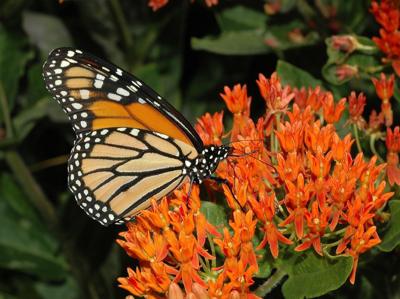
(above) A monarch butterfly feeds on an orange milkweed, which is a member of the only plant family on which they lay their eggs.
Native American Plants
‘NATIVES’
I originally posted this article in March of 2019 but because of its importance to our environment and our native pollinators I believe it’s worth posting again.
There is a renewed interest in growing ‘native’ plants throughout the nation. Although gardens go though trends of what is popular at the time, there are many good reasons for planting some natives everywhere we can.
Over the centuries native plants have adapted to their environment; our soil and weather making them more disease resistant and easier to take care of. Native plants and insects have evolved in a symbiotic relationship with flowers perfect for their pollinators.Now it is impossible for Monarch butterflies to survive without the native milkweed plants on which it lays its eggs.
The basic definition of ‘native’ is any plant growing in a habitat without human interference, or New World plants that were growing here before the arrival of Europeans.
There are gardens and meadows devoted to natives as well as pristine habitats such as ‘The Great Swamp’ in Basking Ridge, NJ. Rain Gardens, now popular to help reduce flooding, utilize natives because of their hardiness and ability to filter toxins from the water and soil.
The native plant movement has many followers who are devoted to ‘native only’ gardens.For mainstream gardeners, however, a blend of natives and modern plants with a few annuals is much more practical, especially since we have invested time and money over the years.
Introducing natives to your garden can be as easy as planting a few native bulbs, such as the ‘Turks Cap Lily’. An old fashion lily that blooms in June with elegant speckled orange or white flowers that drip downward. These lilies are so beautiful they are now planted in gardens all over the world.
If you have space and a dramatic setting, native ‘Witch Hazel’ comes into bloom with yellow blossoms in March when nothing else is in bloom.
‘American Beauty Bush’ has a remarkable show of lavender berries streaming down its stems in early autumn.
During late autumn our native ‘Winterberry’ holly drops its leaves and displays bright red berries along its branches deep into winter.
These are just a few of hundreds of different native plants that you can add to your garden.
When planting native shrubs, flowering plants, and bulbs think of its space for the long term. Many gardeners like to put in a plant and if they change their mind, just dig it up and move it, sometimes just a few feet. Many natives have deep taproots which makes them drought resistant but impossible to move successfully. Research your plant’s requirements for sunlight, water and soil before planting to give it a proper start. Proper sunlight increases the energy plants require to produce more flowers.
I encourage everyone to plant a few natives in their garden. If you are at a garden fair or garden center, visit the Native Plants table, or you can find them in catalogs and on the Internet. If every garden has a few native plants, the benefits will ripple though our communities and environment.
We all enjoy showing our gardens to family and friends. When we do it’s always fun to point out “this is a native”.
Keep Keeping Safe,
James





